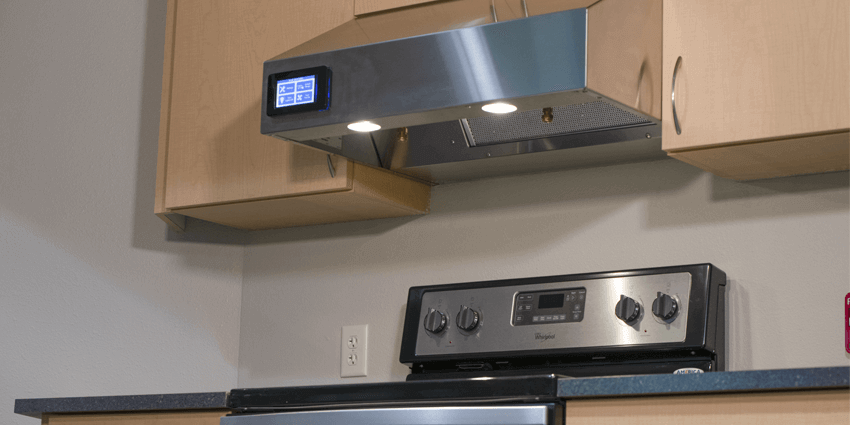How to Select the Best Kitchen Hood for a Residential Kitchen in a Commercial Building

However, attempting to make the same decision for commercial buildings that include residential space or kitchens is far more challenging. Commercial buildings such as college dormitories, churches, multifamily dwellings, assisted living facilities, or fire stations are for now in a gray area of building codes.
Consider the following scenario. A small kitchen is located in a commercial building such as an assisted living facility, fire station or college dormitory. The kitchen prepares food, but not necessarily for resale and profit. The cooking appliances may not be commercial grade. Occupants and or employees living and working in the building consume the food. Other facilities such as training kitchens or kitchens in churches also prepare food and generally do not sell the food for profit. Which kitchen hood is allowed?
It’s Complicated, but Codes Shed Some Light
The answer is complicated. Building codes provide the framework for determining which kitchen exhaust hood apply to specific options. The International Building Code (IBC), International Mechanical Code (IMC) and the National Fire Protection Association Life Safety Code (NFPA 101) are the primary building codes.
IMC Section 507 specifically addresses criteria for commercial kitchens as it relates to appliances and kitchen hoods. It states that a Type I or Type II kitchen hoods are required regardless of the appliance type provided the kitchen use is to sell foods made there to make a profit. However, the kitchen used at a fire station, college dormitory or any of the previously mentioned examples do not prepare food for resale. IMC Section 507 then, does not apply.
Another IMC section (505) states that domestic appliances used for a domestic purpose in a commercial setting, must comply with IMC Section 505. This section requires exhaust equipment include a UL 507 listed exhaust fan with discharge outdoors through a sheet metal duct and have make-up air when the system is exhausting at more than 400 cfm.
IBC also provides some direction for residential kitchens in commercial buildings, such as group homes and assisted living facilities. These codes emphasize occupancy classifications for residential kitchens. Because the main purpose of the building space is not the kitchen, the codes focuses on the occupancy group. This occupancy emphasis requires additional features such as prohibiting recirculating fans in the hood while requiring an automatic fire suppression system.
Know Your Kitchen Exhaust Options
Restaurants and commercial kitchens have very specific kitchen exhaust requirements as dictated by building codes and the authority having jurisdiction (AHJ). Type I, Type II or a combination of both are required depending on needs. Residential style kitchens in commercial buildings often follow a different set of requirements. The following kitchen exhaust hood options currently are available:
Option one – a traditional residential hood. These hoods found at many home improvement stores typically are for light-duty (i.e. residential cooking settings) exhaust effluent for the appliance. The hood may satisfy code requirements for lesser occupancies. However, this type of hood does not provide meet most code requirements and lacks important safety features including fuel disconnects and fire suppression to meet codes.
Option two – a commercial kitchen hood. Installing a commercial Type I or Type II hood in a residential style kitchen will meet and frequently exceed all code requirements. The downside is the hood’s size and cost often does not make this option practical.
Option three – an exhaust hood designed specifically for residential kitchens in commercial buildings. These exhaust hoods have a design that meets the requirements for residential style kitchens in commercial buildings without the challenges of size and cost associated with the commercial hood.
Selecting a kitchen exhaust hood for a residential style kitchen located in a commercial building can be challenging. Building codes and the AHJ dictate what is required. However, the building codes for residential style kitchens in commercial buildings often are not clear. Before making any selections, be sure to keep an open dialog the AHJ to maintain compliance and watch for changes in the building codes.
Learn more about kitchen ventilation systems and also download the latest application article on residential style kitchens in commercial buildings.


from